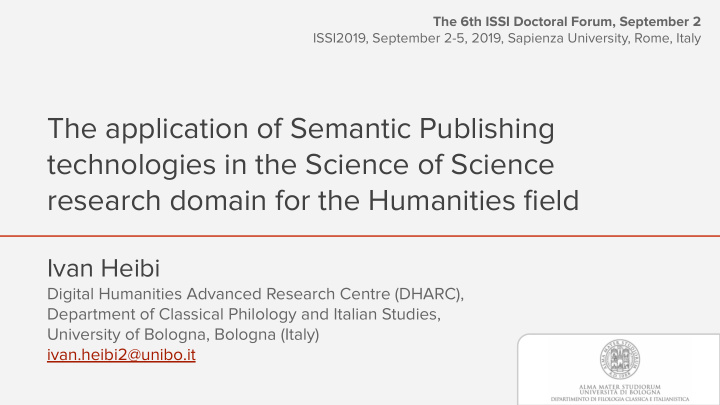



The 6th ISSI Doctoral Forum, September 2 ISSI2019, September 2-5, 2019, Sapienza University, Rome, Italy The application of Semantic Publishing technologies in the Science of Science research domain for the Humanities field Ivan Heibi Digital Humanities Advanced Research Centre (DHARC), Department of Classical Philology and Italian Studies, University of Bologna, Bologna (Italy) ivan.heibi2@unibo.it
About me Bachelor and Master degree in Computer Science at …-2017 the University of Bologna, Italy 2017-18 Research fellow under the supervision of Silvio Peroni on the “ OpenCitations Enhancement Project”, funded by the Alfred P. Sloan Foundation 2018-... Ph.D. student at the Department of Classical Philology and Italian Studies, University of Bologna, Bologna, Italy; The application of Semantic Publishing technologies in the Science of Science research domain
Background Network analysis Large-scale data analysis Social science Science of Science Quantify and predict scientific research and its resulting outcomes for Humanities Semantic Publishing The application of Semantic Web technologies in the scholarly publishing domain .
Background: Semantic Web technologies essentials ● What is it ? An extension of the World Wide Web -> the web of data that can be processed by machines ● How is that possible ? Resources on the web are described using the RDF data model: a Triple (subject, predicate, object), as a graph. subject object General definition predicate Document A cites Document B Semantic publishing Notable examples: OpenCitations, Wikidata/WikiCite, Springer Nature SciGraph, e Microsoft Academic Knowledge Graph Shotton, D. (2009). Semantic publishing: the coming revolution in scientific journal publishing. DOI: https://doi.org/10.1087/2009202
Purpose Analysis strategy: Citations in Humanities ● What are the common formalisms and constructional patterns adopted for citations inside Humanities documents (e.g. a classification according to the document sections) ? 1 ● What are the reasons, i.e. the citation function , to cite other works and what are the most important ones ? [1] Teufel, S., Siddharthan, A., & Tidhar, D. (2006). An annotation scheme for citation function.
The Research ● Resources Focus on journal article-oriented study fields . Books seems to be the most cited doc-type by humanities fields, yet less available. Literature and History are two highly reasonable study fields to take in consideration. ● Limitations The lower proportion of journal articles cited by humanities compared to the scientific oriented domains case; The local relevance ; The presence of a division between publications directed toward researchers and writings directed to a public audience … etc Methodologies ● The Semantic Publishing methods, E.g. using the CiTO (the Citation Typing Ontology) to semantically represent bibliographic citations, or the DataCite Ontology for resources identification … etc ● Desirable outcomes Broaden the knowledge over citations and their usage will lead future researchers improve their works and effectively address their research questions ; Developing new applications that assist the community into a functional usage of the discoveries made.
Project workflow 2 Defining the datasets, resources 1 and tools to use Learning from previous approaches Dataset: OpenCitations Indexes: mainly ● COCI, the OpenCitations Index of Bibliometric and Scientometric techniques Crossref open DOI-to-DOI citations. from the related communities; Study the ● Tool: DIPAM, a Dashboard Interface for past approaches/methods adopted to Python-based Applications Mashup. overwhelm this research limitations ● Tool: OSCAR, the OpenCitations RDF Search Application. 3 4 Answering the Building applications to research questions highlight the discoveries made Ivan Heibi, Silvio Peroni, Paolo Ferri, & Luca Pareschi. (2019, June 27). catarsi/mitao: MITAO first release (Version v1.1-beta). Zenodo. http://doi.org/10.5281/zenodo.3258328 Heibi, I., Peroni, S., & Shotton, D. Enabling text search on SPARQL endpoints through OSCAR. Data Science, (Preprint), 1-23. DOI: https://doi.org/10.3233/DS-190016 Heibi I, Peroni S, Shotton D (2019). COCI, the OpenCitations Index of Crossref open DOI-to-DOI citations. arXiv:1904.06052
Thank you for your attention The application of Semantic Publishing technologies in the Science of Science research domain for the Humanities field Ivan Heibi Digital Humanities Advanced Research Centre (DHARC), Department of Classical Philology and Italian Studies, University of Bologna, Bologna (Italy) ivan.heibi2@unibo.it – @ivanheib – https://ivanhb.github.io
Recommend
More recommend